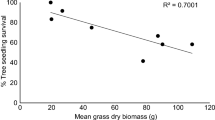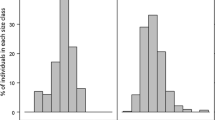Abstract
Over the past century there has been a global trend towards tree expansion and densification in rangelands and savannas. This phenomenon is commonly referred to as bush encroachment. In South Africa Acacia karroo is one of the key species responsible for bush encroachment. It has been suggested that the combination of fire and browsing might limit bush encroachment by A. karroo more effectively than either browsing or fire alone. We hypothesized that these repeated disturbances progressively deplete root carbohydrates and compromise resprouting ability. This was tested by burning and then manually defoliating A. karroo once a month for 1 year. Manual defoliation did not inhibit the rapid shoot elongation after topkill of A. karroo saplings. During this initial phase, the growth of the new shoots of A. karroo was dependent more on mobilised root reserves than on photoassimilates from the new shoots. Frequent manual defoliation of resprouting A. karroo saplings prevented the replenishment of starch reserves. We suggest a mechanism for how the interaction of browsing and fire can suppress and perhaps reverse bush encroachment in African savannas. Saplings that have reduced starch reserves at the end of dry season due to browsing will struggle to resprout if they are burnt. Even if they do not die, they will be less able to escape fire damage in the next fire than if they had been able to resprout unimpeded.




Similar content being viewed by others
References
Archer S, Schimel DS, Holland EA (1995) Mechanisms of shrubland expansion—land-use, climate or CO2. Clim Change 29:91–99
Archibald S, Bond WJ (2003) Growing tall vs. growing wide: tree architecture and allometry of Acacia karroo in forest, savanna, and arid environments. Oikos 102:3–14
Asner GP, Archer S, Hughes RF, Ansley RJ, Wessman CA (2003) Net changes in regional woody vegetation cover and carbon storage in Texas drylands, 1937–1999. Glob Change Biol 9:316–335
Augustine DJ, McNaughton SJ (2004) Regulation of shrub dynamics by native browsing ungulates on East African rangeland. J Appl Ecol 41:45–58. doi:10.1111/j.1365-2664.2004.00864.x
Balfour DA, Howison OE (2001) Spatial and temporal variation in a mesic savanna fire regime: responses to variation in annual rainfall. Afr J Range Forage Sci 19:45–53
Bond WJ, Archibald S (2003) Confronting complexity: fire policy choices in South African savanna parks. Int J Wildland Fire 12:381–389
Bond WJ, Loffell D (2001) Introduction of giraffe changes Acacia distribution in a South African savanna. Afr J Ecol 39:286–294
Bond WJ, van Wilgen BW (1996) Fire and plants. Chapman and Hall, London
Bond WJ, Smythe KA, Balfour DA (2001) Acacia species turnover in space and time in an African savanna. J Biogeogr 28:117–128
Bowen BJ, Pate JS (1993) The significance of root starch in postfire shoot recovery of the resprouter Stirlingia latifolia R.Br. (Proteaceae). Ann Bot 72:7–16
Brooks PM, MacDonald IAW (1983) The Hluhluwe–Umfolozi Reserve: an ecological case history. In: Owen-Smith RN (ed) Management of large mammals in African conservation areas. HAUM, Pretoria, pp 51–77
Canadell J, Lopez-Soria L (1998) Lignotuber reserves support regrowth following clipping of two Mediterranean shrubs. Funct Ecol 12:31–38
Catana AJ (1963) The wandering quarter method of estimating population density. Ecology 44:349–360
Chapin FS, Schulze ED, Mooney HA (1990) The ecology and economics of storage in plants. Annu Rev Ecol Syst 21:423–447
Chuvieco E, Giglio L, Justice C (2008) Global characterization of fire activity: toward defining fire regimes from Earth observation data. Glob Change Biol 14:1488–1502
Cruz A, Perez B, Moreno JM (2003) Resprouting of the Mediterranean-type shrub Erica australis with modified lignotuber carbohydrate content. J Ecol 91:348–356
Dubois M, Gilles KA, Hamilton JK, Rebers PA, Smith F (1956) Colorimetric method for determination of sugars and related substances. Anal Chem 28:350–356
Fensham RJ, Fairfax RJ, Archer SR (2005) Rainfall, land use and woody vegetation cover change in semi-arid Australian savanna. J Ecol 93:596–606
Frost PGH, Robertson F (1987) The ecological effects of fire in savannas. In: Walker BH (ed) Determinants of tropical savannas. ICSU Press, Miami, pp 93–140
Gignoux J, Clobert J, Menaut JC (1997) Alternative fire resistance strategies in savanna trees. Oecologia 110:576–583
Glitzenstein JS, Platt WJ, Streng DR (1995) Effects of fire regime and habitat on tree dynamics in north Florida longleaf pine savannas. Ecol Monogr 65:441–476
Govender N, Trollope WSW, Van Wilgen BW (2006) The effect of fire season, fire frequency, rainfall and management on fire intensity in savanna vegetation in South Africa. J Appl Ecol 43:748–758
Hester AJ, Scogings PF, Trollope WSW (2006) Long-term impacts of goat browsing on bush-clump dynamics in a semi-arid subtropical savanna. Plant Ecol 183:277–290
Hobbs RJ, Mooney HA (1986) Community changes following shrub invasion of grassland. Oecologia 70:508–513
Hoffman MT, O’Connor TG (1999) Vegetation change over 40 years in the Weenen/Munden area, KwaZulu-Natal: evidence from photo-panoramas. Afr J Range Forage Sci 16:78–88
Hoffman MT, Todd SW, Ntshona S, Turner S (1999) Land degradation in South Africa. A report prepared for the South African Department of Environmental Affairs and Tourism. National Botanical Institute, Cape Town
Holdo RM, Holt RD, Fryxell JM (2009) Grazers, browsers, and fire influence the extent and spatial pattern of tree cover in the Serengeti. Ecol Appl 19:95–109. doi:10.1890/07-1954.1
Kays JS, Canham CD (1991) Effects of time and frequency of cutting on hardwood root reserves and sprout growth. For Sci 37:524–539
Kozlowski TT (1992) Carbohydrate sources and sinks in woody-plants. Bot Rev 58:107–222
Landhäusser SM, Lieffers VJ (2002) Leaf area renewal, root retention and carbohydrate reserves in a clonal tree species following above-ground disturbance. J Ecol 90:658–665
Latt CR, Nair PKR, Kang BT (2001) Reserve carbohydrate levels in the boles and structural roots of five multipurpose tree species in a seasonally dry tropical climate. For Ecol Manag 146:145–158
Lett MS, Knapp AK (2005) Woody plant encroachment and removal in mesic grassland: production and composition responses of herbaceous vegetation. Am Midl Nat 153:217–231
Loescher WH, McCamant T, Keller JD (1990) Carbohydrate reserves, translocation, and storage in woody plant-roots. Hortscience 25:274–281
McCleary BV, Gibson TS, Mugford DC (1997) Measurement of total starch in cereal products by amyloglucosidase-alpha-amylase method: collaborative study. J AOAC Int 80:571–579
Miyanishi K, Kellman M (1986) The role of root nutrient reserves in regrowth of two savanna shrubs. Can J Bot Rev Can Bot 64:1244–1248
Newell EA, Mulkey SS, Wright SJ (2002) Seasonal patterns of carbohydrate storage in four tropical tree species. Oecologia 131:333–342
O’Connor TG (1995) Acacia karroo invasion of grassland—environmental and biotic effects Influencing seedling emergence and establishment. Oecologia 103:214–223
Roques KG, O’Connor TG, Watkinson AR (2001) Dynamics of shrub encroachment in an African savanna: relative influences of fire, herbivory, rainfall and density dependence. J Appl Ecol 38:268–280
Schutz AEN, Bond WJ, Cramer MD (2009) Juggling carbon: allocation patterns of a dominant tree in a fire-prone savanna. Oecologia 160:235–246. doi:210.1007/s00442-00009-01293-00441
Scogings PF, Macanda M (2005) Acacia karroo responses to early dormant season defoliation and debarking by goats in a semi-arid subtropical savanna. Plant Ecol 179:193–206
Silva JF, Zambrano A, Farinas MR (2001) Increase in the woody component of seasonal savannas under different fire regimes in Calabozo, Venezuela. J Biogeogr 28:977–983
Skowno AL, Midgley JJ, Bond WJ, Balfour D (1999) Secondary succession in Acacia nilotica (L.) savanna in the Hluhluwe Game Reserve, South Africa. Plant Ecol 145:1–9
Staver AC, Bond WJ, Stock WD, van Rensburg SJ, Waldram MS (2009) Browsing and fire interact to suppress tree density in an African savanna. Ecol Appl 19:1909–1919. doi:1910.1890/1908-1907.1901
Stuart-Hill GC, Tainton NM (1989) The competitive interaction between Acacia karroo and the herbaceous layer and how this is influenced by defoliation. J Appl Ecol 26:285–298
Teague WR (1989) Effect of intensity and frequency of defoliation on aerial growth and carbohydrate reserve levels in Acacia karroo plants. J Grassl Soc S Afr 6:132–138
Trollope WSW (1984) Fire in savanna. In: de V. Booysen P, Tainton NM (eds) Ecological effects of fire in South African ecosystems. Springer-Verlag, Berlin, pp 149–177
Walters M, Midgley JJ, Somers MJ (2004) Effects of fire and fire intensity on the germination and establishment of Acacia karroo, Acacia nilotica, Acacia luederitzii and Dichrostachys cinerea in the field. BMC Ecol 4:3. doi:10.1186/1472-6785-4-3
Ward CJ (1962) Report on scrub control in the Hluhluwe Game Reserve. Lammergeyer 2:32–57
Ward D (2005) Do we understand the causes of bush encroachment in African savannas? Afr J Range Forage Sci 22:101–105
Watson HK, MacDonald IAW (1983) Vegetation changes in the Hluhluwe–Umfolozi Game Reserve Complex from 1937 to 1975. Bothalia 14:265–269
Whateley A, Porter RN (1983) The woody vegetation communities of the Hluhluwe-Corridor-Umfolozi Game Reserve Complex. Bothalia 14:745–758
Whateley A, Wills AJ (1996) Colonization of a sub-tropical woodland by forest trees in South Africa. Lammergeyer 44:19–30
Wigley BJ, Cramer MD, Bond WJ (2009) Sapling survival in a frequently burnt savanna: mobilisation of carbon reserves in Acaica karroo. Plant Ecol 203:1–11. doi:10.1007/s11258-008-9495-x
Wildy DT, Pate JS (2002) Quantifying above- and below-ground growth responses of the western Australian oil mallee, Eucalyptus kochii subsp plenissima, to contrasting decapitation regimes. Ann Bot 90:185–197
Williams RJ, Cook GD, Gill AM, Moore PHR (1999) Fire regime, fire intensity and tree survival in a tropical savanna in northern Australia. Aust J Ecol 24:50–59
Acknowledgments
This project formed part of the Zululand Tree Project (ZLTP), which was funded by the National Research Fund (NRF) of South Africa and the Andrew Mellon Foundation. AENS also received bursary funding from the NRF. We thank the ZLTP staff for logistical help in the field. We also thank Ezemvelo KZN Wildlife for permission to work in HiP.
Author information
Authors and Affiliations
Corresponding author
Rights and permissions
About this article
Cite this article
Schutz, A.E.N., Bond, W.J. & Cramer, M.D. Defoliation depletes the carbohydrate reserves of resprouting Acacia saplings in an African savanna. Plant Ecol 212, 2047–2055 (2011). https://doi.org/10.1007/s11258-010-9883-x
Received:
Accepted:
Published:
Issue Date:
DOI: https://doi.org/10.1007/s11258-010-9883-x




